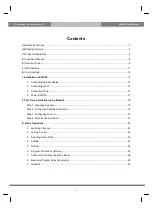
Warning for Your Protection
1. Read these instructions.
2. Keep these instructions.
3. Heed all warnings.
4. Follow all instructions.
5. Do not use this apparatus near water.
6. Clean only with a dry cloth.
7. Do not block any of the ventilation openings. Install in accordance with the manufacturer’s instructions.
8. Do not install near any heat sources such as radiators, heat registers, stoves, or other apparatus (including amplifiers) that produce heat.
9. Do not defeat the safety purpose of the polarized or grounding‐type plug. A polarized plug has two blades with one wider than the other. A
grounding type plug has two blades and a third grounding prong. The wide blade or the third prong is provided for your safety. If the provided plug
does not fit into your outlet, consult an electrician for replacement of the obsolete outlet.
10. Protect the power cord from being walked on or pinched, particularly at plugs, convenience receptacles, and the point where they exit from the
apparatus.
11. Only use attachments/accessories specified by the manufacturer.
12. Use only with the cart, stand, tripod, bracket, or table specified by the manufacturer, or sold with the apparatus. When a cart is used, use
caution when moving the cart/apparatus combination to avoid injury from tip‐over.
13. Unplug this apparatus during lightning storms or when unused for long periods of time.
14. Refer all servicing to qualified service personnel. Servicing is required when the apparatus has been damaged in any way, such as power‐supply
cord or plug is damaged, liquid has been spilled or objects have fallen into the apparatus, the apparatus has been exposed to rain or moisture, does
not operate normally, or has been dropped.
The apparatus shall not be exposed to dripping or splashing. No objects filled with liquids, such as vases, shall be placed on the apparatus.
“WARNING: To reduce the risk of fire or electric shock, do not expose this apparatus to rain or moisture.”
General Installation Instructions
Please consider these general instructions in addition to any product‐specific instructions in the “Installation” chapter of this manual.
Unpacking
Check the equipment for any transport damage. If the unit is mechanically damaged, if liquids have been spilled or if objects have fallen into the
unit, it must not be connected to the AC power outlet, or it must be immediately disconnected by unplugging the power cable. Repair must only be
performed by trained personnel in accordance with the applicable regulations.
Installation Site
Install the unit in a place where the following conditions are met:
The temperature and the relative humidity of the operating environment must be within the specified limits during operation of the
unit. Values specified are applicable to the air inlets of the unit.
Condensation may not be present during operation. If the unit is installed in a location subject to large variations of ambient
temperature (e.g. in an OB‐van), appropriate precautions must be taken.
Unobstructed airflow is essential for proper operation. Ventilation openings of the unit are a functional part of the design and must
not be obstructed in any way during operation (e.g. ‐ by objects placed upon them, placement of the unit on a soft surface, or
improper installation of the unit within a rack or piece of furniture).
The unit must not be unduly exposed to external heat sources (direct sunlight, spot lights).
Ambient
Temperature
Units and systems by FiberPlex are generally designed for an ambient temperature range (i.e. temperature of the incoming air) of 5 °C to 40 °C (41
°F to 104 °F). When rack mounting the units, the following facts must be considered:
The permissible ambient temperature range for operation of the semiconductor components is 0 °C to +70 °C (32 °F to 158 °F)
(commercial temperature range for operation).
The airflow through the installation must allow exhaust air to remain cooler than 70 °C (158 °F) at all times.
Average temperature increase of the cooling air shall be about 20 °C (68 °F), allowing for an additional maximum 10 °C increase at
the hottest components.
If the cooling function of the installation must be monitored (e.g. for fan failure or illumination with spot lamps), the exhaust air temperature must
be measured directly above the modules at several places within the enclosure.
Grounding and Power Supply
Grounding of units with mains supply (Class I equipment) is performed via the protective earth (PE) conductor integrated in three‐pin Phoenix™
connector. Units with battery operation (< 60 V, Class III equipment) must be earthed separately. Grounding the unit is one of the measures for
protection against electrical shock hazard (dangerous body currents). Hazardous voltage may not only be caused by defective power supply
insulation, but may also be introduced by the connected audio or control cables.
This equipment may require the use of a different line cord, attachment plug, or both, depending on the available power source at installation. If
the attachment plug needs to be changed, refer servicing to qualified personnel.




































